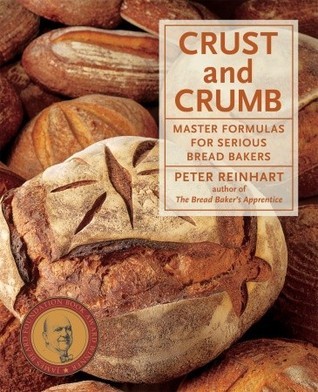What do you think?
Rate this book


224 pages, Paperback
First published January 1, 1998
Since that time a new paradigm, what I call the "bread revolution," has been gradually manifesting itself in many forms. [...] The bread revolution was fought and won on all three fronts: whole-grain awareness, traditional methodology, and neotraditional creativity. This book is an instruction manual for the home baker who want to heed the call to arms. Evidence of the revolution is springing up like loaves out of a hot oven as new bakeries appear daily [... and so on, and so on...] [A New Paradigm, p5]
~ ~ ~ ~
Rustic breads will also really impress your friends and family, converting those few stragglers who have not yet joined the bread revolution. [Rustic Breads, p47]
~ ~ ~ ~
The revolution of crust and crumb is close to being won [...] and the public's hunger for real bread are all signs of victory [...] [M]y hope is that the next wave in the bread revolution will find us well-armed and prepared to lead and inspire future generations. [Postscript | Resources, p195 ]
Art. 2. -Peuvent seuls être mis en vente ou vendus sous la dénomination de : "pain de tradition française", "pain traditionnel français", "pain traditionnel de France" ou sous une dénomination combinant ces termes les pains [...] ne contenant aucun additif et résultant de la cuisson d’une pâte qui présente les caractéristiques suivantes :
1° Etre composée exclusivement d’un mélange de farines panifiables de blé, d’eau potable et de sel de cuisine ;
2° Etre fermentée à l’aide de levure de panification (Saccharomyces cerevisiae) et de levain, au sens de l’article 4 du présent Décret, ou de l’un seulement de ces agents de fermentation alcoolique panaire ;
3° Eventuellement contenir, par rapport au poids total de farine mise en oeuvre une proportion maximale de :
a) 2 p. 100 de farine de fèves ;
b) 0,5 p. 100 de farine de soja ;
c) 0,3 p. 100 de farine de malt de blé.
[...]
Art. 4. -Le levain est une pâte composée de farine de blé et de seigle ou de l’un seulement de ces deux ingrédients, d’eau potable éventuellement additionnée de sel et soumise à une fermentation naturelle acidifiante, dont la fonction est d’assurer la levée de la pâte.
[(source: cooksinfo.com/french-bread-law-1993)]